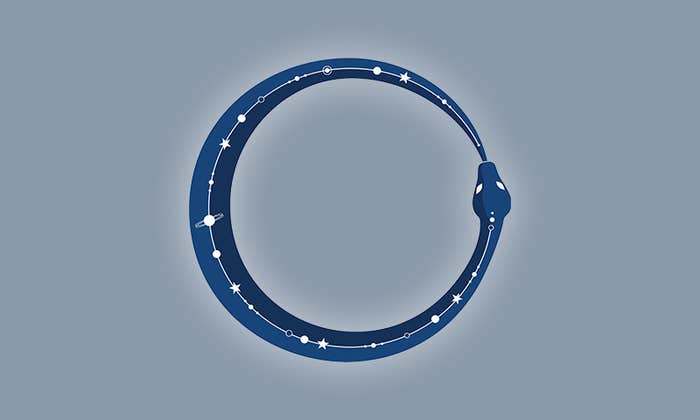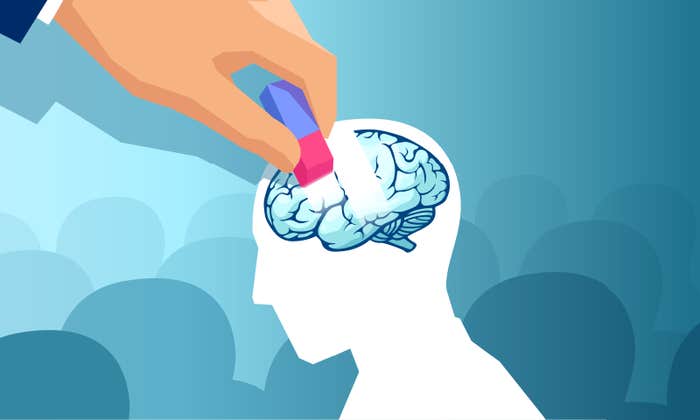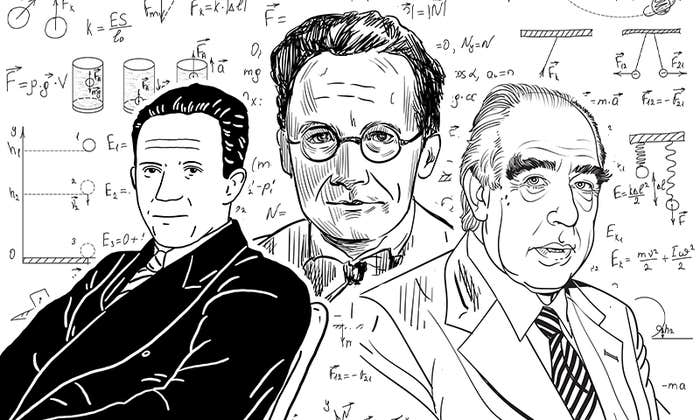Einstein finished his masterwork, the theory of general relativity, in 1915. He was 37 years old and would live for another 40 years. He spent these decades in the attempt to explain that everything—matter, energy, and even ourselves—were simply deformations of spacetime.
Einstein, feeling that his theory of general relativity was incomplete, wanted to develop a unified field theory—a framework that would combine space and time with energy and matter. (Indeed, it was Einstein who coined the term “unified theory.”) He ultimately failed. But I have begun to wonder if his idea, as ambitious as it was startling, isn’t worth revisiting.
Einstein built his unified theory off of general relativity, which says that gravity is a property of spacetime. This is often depicted with a marble that weighs down a rubber sheet. The rubber sheet is spacetime, the marble’s mass provides gravity. If a smaller marble rolls by the larger one, it will not roll in a straight line. It will roll in a curve as if it was attracted to the bigger marble. You need that marble to cause the curvature in the first place. It’s the same in Einstein’s general relativity: You need spacetime and matter in it to describe what we see happening in the universe.
Einstein seems to have tried to find a theory in which there is only spacetime and no matter—and in which we only interpret some of the spacetime as matter. He wanted to find equations that would have solutions that correspond to the fundamental particles of nature, such as electrons.
Einstein and Rosen assumed the black hole has no inside and instead connects two universes.
When Einstein set out to find this theory, in the first half of the 20th century, physicists’ knowledge of the properties of matter and how it behaved were incomplete. Today, we know of four fundamental interactions. Beside gravity, there’s electromagnetism and the strong and weak nuclear interactions. But in the early 20th century, the strong nuclear interaction had not yet been discovered, and the theory for the weak nuclear interaction had not yet been developed. Einstein therefore really only had two interactions to work with to make sense of matter: gravity and electromagnetism. The gravitational force law, also known as Newton’s law, is similar to that for electric charges, known as Coulomb’s law. And because Einstein had been so successful with describing gravity as the curvature of space, he wondered whether electromagnetism could be described in much the same way.
In 1919, Einstein published a paper titled “Do gravitational fields play an essential role in the structure of the elementary particles of matter?” The idea he pursued in the paper was to take a modified version of general relativity, with different field equations, then add electromagnetism and ask whether this would give rise to solutions that could be interpreted as particles.
The conclusion he arrived at is: No, this doesn’t work because the quantity that could be interpreted as mass could take on any value, whereas the particles that matter are made of have very specific values.
In 1923, he published another paper in which he basically said that his previous idea to make matter from spacetime didn’t work because there were some equations missing. He then proposed some equations that might do the job … but again concluded that this doesn’t work
In 1925, he published yet another paper in which he said that he had been trying for two years to combine electromagnetism with gravity, and it didn’t work.
But Einstein had another clue for his unified theory: black holes.
You see, as soon as Einstein had finished his theory of general relativity, the German physicist and astronomer Karl Schwarzschild discovered a solution to Einstein’s equations that described what we now call black holes. But this solution has singularities, places where some quantities take on infinite values. Einstein thought that this couldn’t be right. Singularities shouldn’t happen in reality. And if his theory allowed those, then there was something wrong with it. He therefore tried to use the requirement that singularities should be absent to go back and find solutions that would describe elementary particles.
But he made a mistake there. In Schwarzschild’s black hole solution, there isn’t just one singularity, but two. One is at the horizon of the black hole, the other in the center. We know today that the singularity at the horizon does not correspond to any physically measurable quantity. It’s a mathematical artifact that can be removed. Einstein tried to find a way to remove this singularity that wasn’t there. (You’d think that physicists would have learned from this that it’s a mistake to go on about the properties of unobservable quantities, but still, it’s the same mistake that led to all these wrong predictions for the Large Hadron Collider. But I digress.)
I want to call this Einstein’s Other Theory of Everything: that matter is really just made of spacetime.
Einstein’s quest to get rid of black hole singularities is what led to his famous paper with Nathan Rosen in 1935, in which they introduced what is now called an Einstein-Rosen bridge. They assumed the black hole has no inside and instead connects two universes. It’s the simplest known example of a wormhole.
But they didn’t write the paper to introduce wormholes. Einstein and Rosen thought these wormholes were elementary particles. After they’d constructed their bridge, they wrote very clearly, “We see now in the given solution, free from singularities, the mathematical representation of an elementary particle (neutrons or neutrinos).”
They then went on to add electric charges and interpreted those as charged particles. Now, we know today that neutrons are not elementary particles, they are made of smaller particles (quarks and gluons). But this wasn’t the main problem with the idea. The main problem is that one can calculate the size of the bridge, or wormhole, or whatever you want to call it, from its mass. And that’d tell you that the “size” of a neutron would be about 10-52 centimeters. That’s more than 30 orders of magnitude smaller than its actual size. For other elementary particles, this becomes even more extreme.
This means that if elementary particles were wormholes or black holes, they would be much smaller than the quantum uncertainty that we measure. (Stephen Hawking also taught us that they’d be unstable, but again, Einstein couldn’t have known this.)
In any case, he didn’t pursue this idea further. Instead, he pursued a different direction which he had proposed in 1925: that the properties of matter are encoded in the relations between different locations in spacetime, an approach that he dubbed “tele-parallelism.” It is this tele-parallelism that later became known as Einstein’s unified field theory. It has, however, little to do with his original idea.
This teleparallel approach to a unified field theory was not pursued after Einstein’s death in 1955. Because by then it had become clear that it wasn’t compatible with the new things that physicists had discovered, such as the weak and strong nuclear forces.
That said, I find it somewhat surprising—and maybe even concerning—that physicists have also thrown out Einstein’s original idea, that I want to call his Other Theory of Everything: that matter is really just made of spacetime, curved in a particular way. The notion has survived in some areas of physics, where such objects are known as “solitons”—or noise-free subsystems—but mostly it’s been given up.
It has been replaced by a different idea of unification, that matter and spacetime are both made of something else, such as, for example, strings or loops or networks.
So why am I returning to this old story? Primarily because I think it’s interesting what Einstein, undoubtedly one of the most intelligent people to walk on this planet, did with much of his life. But also because I don’t want Einstein’s idea—about what we and the universe might be made out of—to be forgotten. ![]()
Lead image: Muhammad suryanto / Shutterstock



























